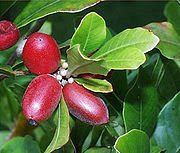Rooty, Tooty, Fresh and Fruity!!
Say this ten times fast – “Synsepalum dulcificum.” Well, the easier name for the item at hand is “miracle fruit.” I came across an article awhile back and was immediately intrigued.
The “miracle fruit” is the size of about an almond but otherwise looks similar like a cranberry. So now, the crazy cool thing about this little nugget of curiosity is that when you eat one and the pulp rubs across your tongue it has an altering effect for the next 15-20 minutes. It turns bitter, sour and acidic foods into sweet foods that taste like candy. Turning fruit into candy? Yes, please!! So, for foodies alike, of course this sounds fun, easily and safely changing how food tastes? It’s like the most fun science experiment, ever!!
But, here’s the part that I think is so unbelievable. While this little fruit provides solely entertainment for most, for people with cancer this fruit can really earn it’s name. For those bravely enduring chemotherapy, one of the side effects is a terrible metallic taste that remains in your mouth, so bad that many stop eating. This can result in a dramatic amount of weight loss and can lead to malnutrition. Enter the possibility of the “miracle fruit.” According to Dr. Mike Cusnir, an oncologist at Mt.Sinai Medical Center, a majority of patients participating in a study that uses the “miracle fruit” gave good feedback that it improved the taste of food. And while it is in the very beginning steps of investigation by doctors, I am very optimistic that this could help many people!
How does it work? Well, let me channel my inner Alton Brown (my college degree is in Food Science and Nutrition after all!!) and explain to you the science behind it. To put it simply (with information from Linda Bartoshuk, a professor at the Uof F Center for Smell and Taste) there is a protein called miraculin in the fruit which has sugar molecules that bind to the tongue. Once an acid of a certain pH hits the tongue, the sugar molecules press into the sweet receptors, thus masking the sour or bitter taste. Again, that was the simple explanation and for further detail simply Google “synsepalum dulcificum miraculim” and you will find plenty of articles to explain in much further detail (such as pH boundaries, temperature restrictions, histidine presence, etc.).
There is also some discussion of the possibility of using the fruit for weight loss, specifically for those with diabetes. Because the fruit is all-natural and has few calories, and because of the ability to turn the taste of healthy fruits into a candy-riffic experience, the researchers hope that will help curb dessert cravings so people can sub fruit instead.
So, next time your niece, nephew, son or daughter asks for some help with a science experiment suggest Synsepalum dulcificum. They’ll come across as super smart and super cool.


